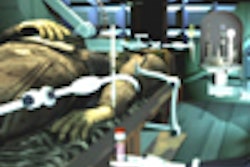A new report updates the recommended colonoscopy follow-up guidelines in the U.S. following the resection of colorectal cancer stages I-III. The recommendations, published in CA: A Cancer Journal for Clinicians and approved by a broad swath of medical advisory organizations, address only postsurgical endoscopic surveillance.
Still, virtual colonoscopy providers can glean important information from the recommendations, which are based on a comprehensive evaluation of 66 studies and serve to advance the understanding of the risk of new cancers following colonoscopic (stage I) or surgical (stages II-IV) resection. The prognosis varies widely depending on the type and location of the cancer, patient demographics, and surgical method used.
Inasmuch as virtual colonoscopy has been suggested as a beneficial and noninvasive surveillance method, particularly for reducing the risk of complications in frequent follow-ups, VC providers may find the information useful for optimizing their own follow-up intervals.
The lead author of the new guidelines was Dr. Douglas Rex, a professor of medicine at the Indiana University School of Medicine in Indianapolis and chair of the U.S. Multisociety Task Force on Colorectal Cancer. His co-authors include Dr. Charles Kahi, also from Indiana University; Dr. Bernard Levin from the University of Texas M. D. Anderson Cancer Center in Houston; and other leading colorectal cancer specialists in the U.S.
According to the team, the surveillance of patients with resected colon or rectal cancer has two main goals: early detection of recurrent tumors and the detection of metachronous colorectal neoplasms.
There is a rationale for using surveillance to detect local recurrence. However, the authors noted that postsurgery surveillance has not passed the more stringent test of increased survival.
"Neither individual randomized controlled trials of intensive surveillance with colonoscopy, nor meta-analyses have demonstrated a survival benefit from the original primary tumor by performing colonoscopy at annual or shorter intervals," the team wrote. The reasons behind the lack of increased survival "appears to result from relatively low rates of anastomotic intraluminal recurrence and the observation that anastomotic or intraluminal recurrences are generally associated with intra-abdominal or pelvic disease that is unresectable for cure," they wrote, noting that nearly all patients with anastomotic recurrences are unresectable for cure, and should not be followed with colonoscopy (CA: A Cancer Journal for Clinicians, May-June 2006, Vol. 56:3, pp. 160-167).
"On the other hand, local recurrence rates of rectal cancer can be 10 or more times higher," Rex and colleagues wrote.
Chemotherapy and radiotherapy can reduce local recurrence rates, especially in the preoperative setting. For rectal cancer a surgical technique called mesorectal excision, which involves sharp dissection of the rectum and surrounding adventitia along the mesorectal fascia, has whittled recurrence rates for these patients to less than 10%, the team wrote. And when cancers are resected endoscopically, follow-up colonoscopy is the standard of care to avoid piecemeal resection.
"Among studies of postcancer resection surveillance colonoscopy, there were 57 metachronous cancers in the first two years after resection of the initial primary," the group noted, for an incidence of 0.7%. "This estimate is consistent with a review of tumor registries in Nebraska, which calculated an annual incidence for metachronous cancers of 0.35% per year. When reported, 69 of 106 (65%) of metachronous cancers were Dukes' stage A or B, 29 of 52 were asymptomatic, and 62 of 71 were operated for cure."
The findings were sufficient to recommend follow-up colonoscopy at one year, the group wrote.
Follow-up recommendations
The updated guidelines recommend that the colorectum should be cleared of synchronous neoplasia in the perioperative period, with colonoscopy performed preoperatively in nonobstructive colons, double-contrast barium enema or virtual colonoscopy in obstructed colons, and colonoscopy performed three to six months after surgery. After clearing for synchronous disease, another colonoscopy should be performed a year later to look for metachronous lesions.
"If the examination at one year is normal, then the interval before the next subsequent examination should be three years," the group wrote. "If that colonoscopy is normal, then the interval before the next subsequent examination should be five years."
"Shorter intervals may be indicated by associated adenoma findings.... Shorter intervals are also indicated if the patient's age, family history, or tumor testing indicate definite or probably hereditary nonpolyposis colorectal cancer," they wrote.
Patients who undergo low anterior cancer resection generally have higher recurrence rates than those with colon cancer, the group noted.
The researchers did not recommend virtual colonoscopy for any role in follow-up examination; however, they did eek out minor roles for flexible sigmoidoscopy and endoscopic ultrasound.
"Although effectiveness is not proven, performance of endoscopic ultrasound or flexible sigmoidoscopy at three- to six-month intervals for the first two years after resection can be considered for the purpose of detecting a surgically curable recurrence of the original rectal cancer, they wrote
Immunochemical fecal occult blood testing warrants additional evaluation as an adjunct to colonoscopy in postsurgery follow-up setting, the group added.
The new guidelines have been endorsed by the Colorectal Cancer Advisory Committee of the American Cancer Society and by the governing boards of the American College of Gastroenterology, American Gastroenterological Association, and American Society for Gastrointestinal Endoscopy.
By Eric Barnes
AuntMinnie.com staff writer
July 4, 2006
Related Reading
VC finds risky polyps, might reduce polypectomies, June 8, 2006
VC effective in postpolypectomy follow-up, March 4, 2006
Adverse events weigh on colonoscopy mortality equation, February 6, 2006
Ursodeoxycholic acid may help prevent colorectal adenoma recurrence, June 7, 2005
Colonoscopy performed too often after polypectomy, August 17, 2004
Copyright © 2006 AuntMinnie.com




















